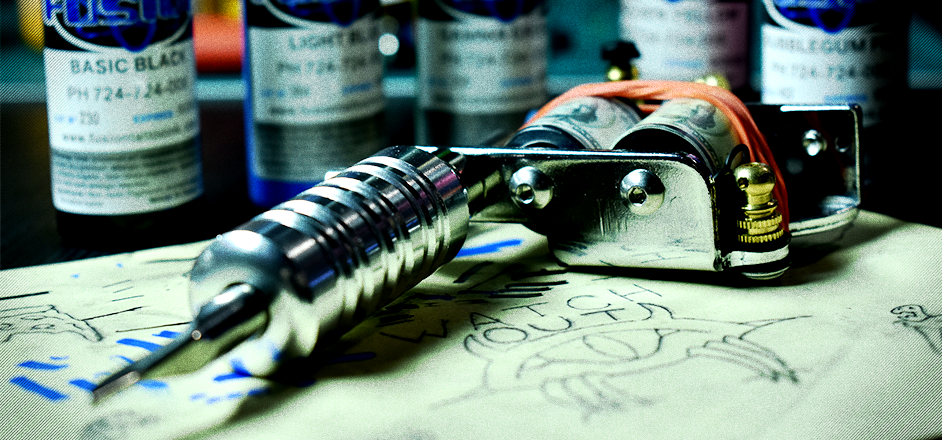Sitting in a room filled with art not his own, a student observes and learns from a master. The soft buzz of the tattoo gun starkly contrasted with the work in front of them: blood, ink, and sweat.
The master, a man known as El Guapo quietly shows his student, Mijo, the ins and outs of what it takes to start the journey to becoming a professional tattoo artist.
A lot of artists today think they have what it takes to make the jump to tattoo artist. And with all that money they’re making, why wouldn’t you? You can order a tattoo kit off Amazon for close to $20. A set of quality gear is going to cost you closer to $4,000 though, according to industry professionals.
“Now people can order a kit online and say they’re a ‘tattooer’ with no real experience or credibility,” Mijo said. Given how accessible the tools are now, he’s seeing a wave of younger artists wanting a crack at it. His advice to aspiring tattoo artists: “Get tattooed. A lot. You might hate it, in which case, get the fuck out of here.”
Fresh out of high school with only a few art classes under his belt, Mijo had his sights set on tattooing since adolescence. After receiving his first tattoo at 17 (his last name across his stomach) Mijo sought out the man who gave it to him. But raw natural talent and an insatiable appetite to learn proved not enough.
He spent countless hours simply hanging around the shop, cracking jokes and doing favors to win over Guapo. One favor included washing his ‘94 Chevy Impala. Okay, maybe Mijo wanted to do that one anyway…But it paid off, with some help from close family friend and shop owner, Brett, Guapo gave in.
Tattooing is an artform unlike most others. Your canvas is the human body. People come in all shapes and sizes, colors and pigments. It’s a living, breathing thing that changes with time.

Learning to tattoo skin isn’t something you can easily mimic, if at all. Every session is a learning experience. Learning how much pressure to apply and when. How to tattoo certain parts of the body and how those parts react differently to the needle than others.
“It doesn’t always translate. Tattooing is different. If you’re a good artist, that doesn’t mean you’ll be a good tattooer,” Mijo said. A tattoo artists must be an artist to begin with, sure, but just because you can paint like Picasso doesn’t mean you can replicate it on the human body.
Mijo spends most of his spare time drawing. This is how he improves and maintains his artistic abilities since you can’t always practice on skin (obviously). But even a lifetime of sketching can’t simulate what real life experience can. And real life experience can only be found through an apprenticeship, but getting that apprenticeship isn’t going to be cheap.
In a heavily regulated state, an apprenticeship can cost you upwards of $10,000. That’s not to say you can’t get one for free, but then again, why would they? Think of it like going to college. You're paying for a better education to separate yourself from the “other guy.”
When asked if he had to pay for his apprenticeship, Mijo responded, “fuck yeah I did.” Even though Brett and Guapo were close family friends he still had to pay his dues like everyone before him.
In the past, an apprentice wasn’t even allowed to look at a tattoo machine until he’d been there X amount of months, Mijo recalled. You had to earn it. Younger artists want to bypass this tradition and get straight to making money.
“If someone goes out and buys something online and practices for long enough there gonna get how to do it, ya know? It’s not the hardest thing ever. Kids teach themselves a lot more difficult things all the time, but you’re not gonna get that know-how. You’re not gonna be exposed to the cool flash from back in the day, or the trade secrets that go along with it.”
During his apprenticeship, daily life consisted of everything business related that wasn’t tattooing. Cleaning tubes, preparing needles, answering the phone and dealing with customers, to name a few. He’d always be the first one there, an hour early, to clean up the shop and prep for the day. Then, once they were open, front desk duties became his main priority when not stocking supplies and helping the artists with whatever else they needed.
“Tattooing was such a small part of it,” he recalled. When he was finally allowed to tattoo a customer— about a year into his apprenticeship— he wasn’t nervous. Actually, quite the opposite. “He [Brett] was like, ‘I‘ve never seen someone not shake doing their first tattoo.” Part of that confidence came from the kind of person Mijo is, but it also came from the experience and knowledge he gained during his apprenticeship. After two years, he finished his apprenticeship and landed his first job at the same shop, the now closed, Purple Lotus in Frisco, Colorado.
Fast forward 11 years and Mijo’s now a seasoned vet at Bolder Ink in Boulder, CO. His focus now (besides crushing tattoos) is on staying healthy so he can continue to do this for as long as his body is able to.
Tattooing requires you to sit for long periods of time, stretching and contorting your body to accommodate the customers needs or location of the tattoo. It’s pretty common for artists to develop tendonitis in there arms, wrists and hands given the repetitive motions involved. Back and neck problems are common too. According to Mijo, a lot of older tattooers are getting on younger guys for their posture. Like your mom. Funny how that works out. Tattooing isn’t a sprint, it’s a marathon, and Mijo’s in it for the long haul.




Leave a Reply